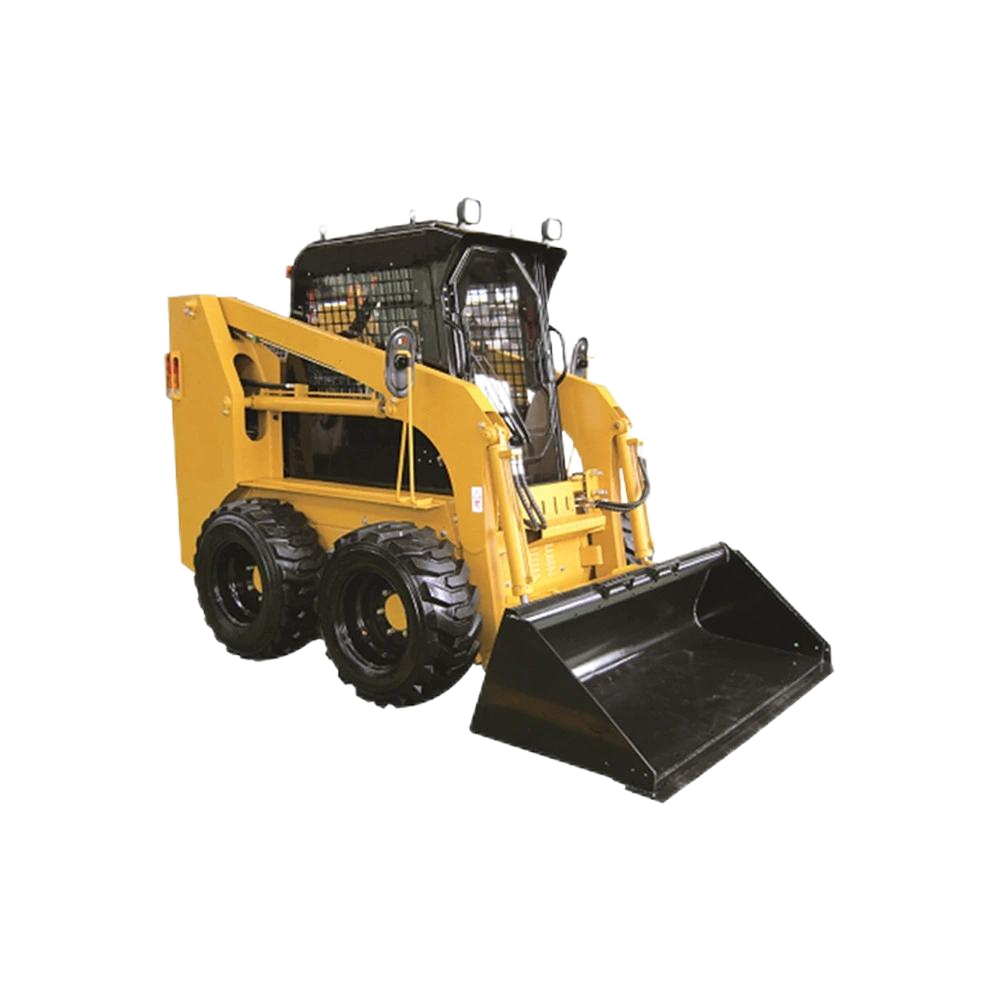Skid-steer loaders differ significantly from other common loaders (such as wheel loaders, crawler loaders, backhoe loaders, etc.) in terms of structural design, operating characteristics, and applicable scenarios. The following is a detailed comparison of their core differences from multiple dimensions:

I. Structural Design and Steering Mode
This is the most core distinguishing feature of skid-steer loaders:
- Skid-steer loaders:
They adopt independent drive for wheels on both sides and realize steering through the speed difference between the wheels on both sides (360° in-place steering can be achieved when one side of the wheels moves forward and the other side moves backward), without the need for an additional steering mechanism. The body is extremely compact (usually 3-5 meters in length and 1.5-2.5 meters in width) with a short wheelbase and no tail overhang. - Wheel/crawler loaders:
They rely on traditional steering axles or hydraulic steering mechanisms, requiring a certain turning radius when steering. The body is longer (wheel loaders are usually 5-8 meters), and the tail may swing out when steering. - Backhoe loaders:
They combine the structure of loaders and excavators. Although the size is relatively flexible, steering still requires a certain amount of space. Moreover, due to the excavating arm, the overall length and operating radius are larger than those of skid-steer loaders.
II. Operational Flexibility and Space Adaptability
- Skid-steer loaders:
They have significant advantages. The in-place steering capability enables them to work efficiently in narrow spaces (such as indoors, roadways, workshops, and small construction sites), with almost no need to reserve additional steering space. The body height is relatively low (usually 2-3 meters), allowing access to low-rise buildings or containers. - Other loaders:
Wheel/crawler loaders, which require a turning radius, are more suitable for open sites (such as mines, large construction sites, and ports); although backhoe loaders can handle both loading and excavating, their overall size is still larger than that of skid-steer loaders, resulting in weaker adaptability to narrow spaces.
III. Functional Diversity and Attachment Compatibility
- Skid-steer loaders:
They take versatility as the core competitiveness. By quickly replacing attachments (dozens of types such as buckets, wood grabs, breakers, sweepers, drills, forklifts, snow blowers, etc.), they can perform nearly a hundred types of operations including loading, handling, crushing, cleaning, and excavating. The replacement of attachments usually takes only a few minutes. - Other loaders:
Wheel/crawler loaders mainly focus on bucket operations. Although they can also replace some attachments, their compatibility and replacement efficiency are far inferior to those of skid-steer loaders; the attachment adaptability of backhoe loaders is concentrated on excavating and loading, with weak functional expandability.
IV. Power and Operational Efficiency
- Skid-steer loaders:
The engine power is usually 20-100 horsepower, and the load capacity is small (0.5-2 tons), suitable for light, short-distance, and fine operations (such as handling small materials and site cleaning). Due to size limitations, their ability to perform continuous high-intensity operations is weak. - Wheel/crawler loaders:
The power can reach 100-500 horsepower, and the load capacity is 3-20 tons, suitable for heavy-load and long-distance handling (such as ore transportation in mines and sand and gravel transfer in large construction sites). Their operational efficiency in heavy-load scenarios is far higher than that of skid-steer loaders. - Backhoe loaders:
Their power and load capacity are between the above two types. They focus on "one machine with two functions" (loading + excavating), but the efficiency of a single function is not as good as that of professional loaders or excavators.
V. Applicable Scenarios
| Equipment Type | Core Applicable Scenarios |
|---|---|
| Skid-steer loaders | Narrow spaces (workshops, roadways, indoors), multi-functional operations (cleaning, crushing, agriculture, sanitation), light handling |
| Wheel loaders | Open sites (mines, ports, large construction sites), heavy-load and long-distance handling |
| Crawler loaders | Muddy/soft ground (infrastructure construction sites, mining areas), heavy-load operations |
| Backhoe loaders | Small and medium-sized construction sites (both loading and excavating, such as rural road construction and small earthworks) |
VI. Operation and Maintenance
- Skid-steer loaders:
The operation difficulty is relatively low. Due to flexible steering, high requirements are placed on the operator's spatial judgment; the body structure is compact, with concentrated maintenance points, making daily maintenance convenient. However, some components (such as drive motors) wear quickly due to high-frequency steering. - Other loaders:
The operation of wheel/crawler loaders focuses more on heavy-load control, and the maintenance cost increases with the increase of power; backhoe loaders have relatively high maintenance difficulty due to their complex structure (including the hydraulic system of the excavating arm).
Summary
The core positioning of skid-steer loaders is "a multi-functional all-rounder in compact spaces", winning with flexibility and functional diversity, and suitable for light, fine, and space-constrained operations; while other loaders focus more on "efficient heavy-load operations in specific scenarios" and have more advantages in open sites or heavy-load demand scenarios. The selection should be comprehensively judged according to the operation space, load demand, and functional diversity requirements.





